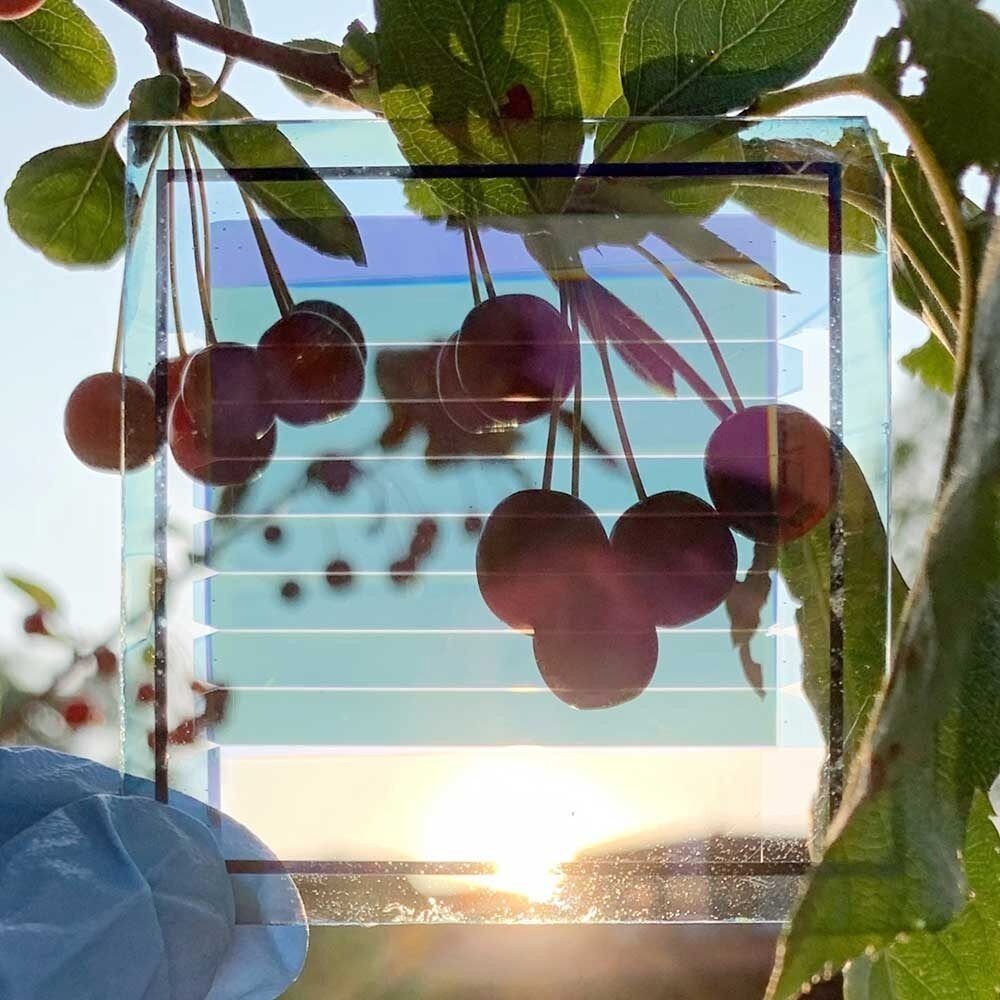The University of Michigan has created a method to produce its extremely effective and semitransparent solar cells, which is a significant step toward delivering transparent solar cells that can be used for home windows.
 Viewed through the semi-transparent solar cells, the cherries on the tree are clearly defined. The new manufacturing process could enable meter-scale electricity-producing windows. Image Credit: Xinjing Huang, Optoelectronic Components and Materials Group, University of Michigan.
Viewed through the semi-transparent solar cells, the cherries on the tree are clearly defined. The new manufacturing process could enable meter-scale electricity-producing windows. Image Credit: Xinjing Huang, Optoelectronic Components and Materials Group, University of Michigan.
In principle, we can now scale semitransparent organic solar cells to two meters by two meters, which brings our windows much closer to reality.
Stephen Forrest, Study Corresponding Author and Peter A. Franken Distinguished University Professor, Electrical Engineering, University of Michigan
The study was published in the journal Joule.
Traditional silicon-based solar cells are fully opaque, which is great for solar farms and rooftops but would be useless for windows. Organic solar cells, on the other hand, may have a transparent light absorber made of a certain kind of plastic.
Due to technical difficulties, including poor efficiency and limited lives, organic solar cells have trailed behind their silicon-based cousins in terms of energy production. However, the new research from Forrest’s lab has reached record efficiencies of 10% with predicted lifetimes of up to 30 years.
As a result, the team is now focused on producing transparent solar cells. The electrical connections between the individual solar module cells at the micrometer size provide a significant challenge. The organic light absorbers are readily damaged by conventional cell patterning techniques that involve lasers.
Instead, researchers created a multistep peel-off patterning technique that produced a resolution down to the micron level. They applied thin plastic sheets and cut them into very tiny strips. The layers of metal and biological material are then applied. The strips were then peeled off, resulting in very tiny electrical connections between the cells.
Eight semitransparent solar cells, each measuring 4 cm × 0.4 cm and joined by 200 µm wide interconnections, were combined to form a single 13 cm2 module. The power conversion efficiency of the module, which was 7.3%, was almost 10% lower than that of the individual solar cells. Similar efficiencies are anticipated for meter-scale panels as well since this little efficiency loss does not grow with module size.
The cells are suited for use in commercial windows since they have a transparency that is over 50% and a greenish tint. This same technology makes it simple to attain higher transparency levels, which are preferable for the home sector.
It is now time to get industry involved to turn this technology into affordable applications.
Xinjing Huang, Study First Author and Doctoral Student, Applied Physics, University of Michigan
The flexible solar cell panel will eventually be positioned in between two window panes. The target for these energy-generating window films is a transparency of around 50% and an efficiency of 10%–15%. Within a few years, according to Forrest, this will likely be accomplished.
The research we are doing is derisking the technology so that manufacturers can make the investments needed to enter large scale production.
Stephen Forrest, Study Corresponding Author and Peter A. Franken Distinguished University Professor, Electrical Engineering, University of Michigan
According to Forrest, the method may be applied to other biological electrical devices. In fact, their team is already using it to create white illumination using OLEDs.
The University of Michigan has filed for patent protection and is looking for collaborators to help commercialize the technology.
Along with teaching electrical and computer engineering, materials science and engineering, physics, and applied physics, Forrest has the Paul G. Goebel Professor of Engineering title. The studies were planned and carried out by co-authors Dejiu Fan (Ph.D. EE 2020), a former doctoral student. The devices were created at the Lurie Nanofabrication Facility with assistance from co-author and assistant research scientist Yongxi Li.
The U.S. Department of Energy provided the majority of funding for the study. Universal Display Corporation gave more assistance. Financial interests in Universal Display Corp. are held by Forrest and U-M.
Journal Reference:
Huang, X., et al. (2022) Multilevel peel-off patterning of a prototype semitransparent organic photovoltaic module. Joule. doi.org/10.1016/j.joule.2022.06.015.